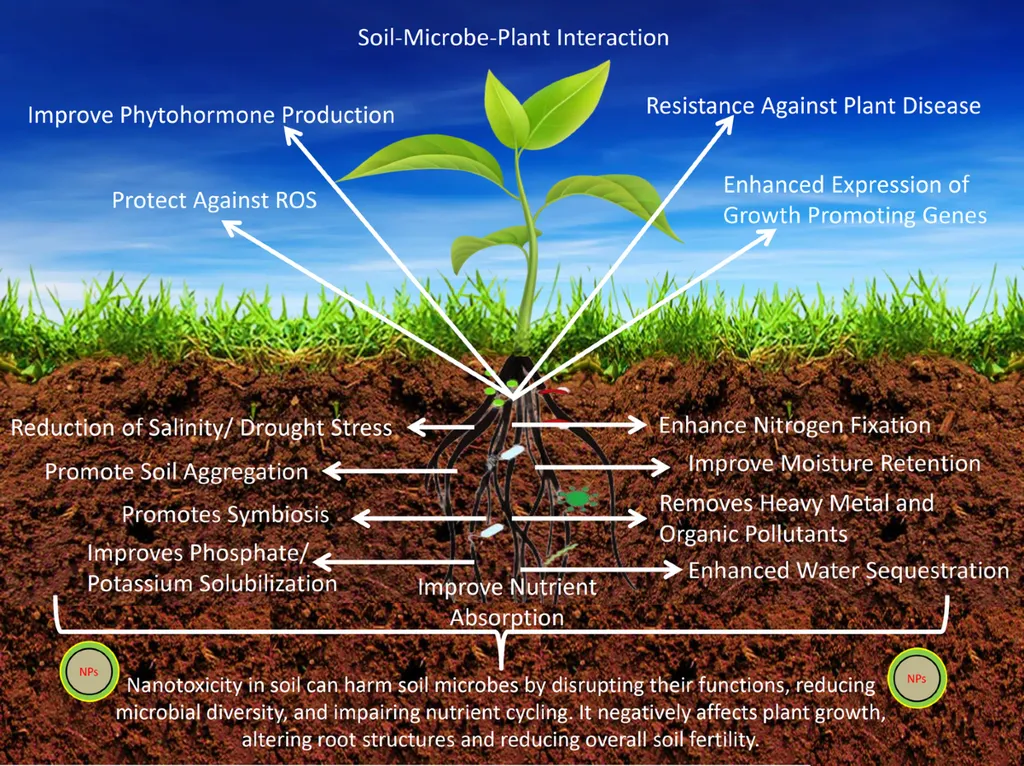In the heart of Assam, India, a groundbreaking study led by Dipayan Das from the Department of Microbiology at The Assam Royal Global University is shedding light on the intricate dance between nanotechnology and soil microbial communities. Published in the journal *Discover Soil* (translated from its original name), this research is not just about tiny particles and microscopic life; it’s about the future of sustainable agriculture and its profound implications for the energy sector.
Nanotechnology is revolutionizing agriculture, promising enhanced crop productivity, nutrient efficiency, and precision pest management. Nano-fertilizers minimize nutrient loss, nano-pesticides target pests with pinpoint accuracy, and nanosensors improve precision farming by detecting contaminants. These advancements contribute to higher yields, resource conservation, and food security. However, the impact of nanotechnology on soil microbial communities remains a critical concern.
Soil microbes, including bacteria and fungi, play essential roles in nutrient cycling, soil structure, and plant health. Sustainable farming relies on maintaining microbial diversity, which supports nutrient uptake, disease suppression, and symbiotic plant interactions. The introduction of nanoparticles into agricultural soils alters soil structure, chemistry, and biological processes. Metal-based nanoparticles can disrupt nutrient cycles, microbial activity, and even induce genetic mutations affecting plant growth.
“Nanoparticles generate reactive oxygen species, leading to oxidative stress in soil organisms,” explains Das. “This can alter microbial physiology and ecosystem balance.” The toxicity of nanoparticles varies based on their chemical composition, solubility, and surface properties. Nanoparticles enter microbial cells through passive diffusion, endocytosis, or membrane disruption, potentially causing cytotoxicity and immune responses.
But microbes are not passive victims. They counteract nanotoxicity through antioxidant production, membrane modifications, efflux pumps, and genetic adaptations such as horizontal gene transfer and biofilm formation. Understanding these microbial responses is essential for developing sustainable agricultural strategies.
The commercial impacts of this research are vast. As the energy sector increasingly relies on biofuels and sustainable agricultural practices, the need to understand and mitigate the effects of nanotechnology on soil health becomes paramount. By regulating nanoparticle use, optimizing nanoparticle design, and implementing soil management practices, we can mitigate risks while leveraging nanotechnology’s benefits.
“This research is a stepping stone towards a future where we can harness the power of nanotechnology without compromising our soil health,” says Das. “It’s about finding that delicate balance between innovation and sustainability.”
As we stand on the brink of a nanotechnology-driven agricultural revolution, this study serves as a crucial reminder of the need for responsible innovation. By analyzing the interactions between nanoparticles and soil microbes, we can pave the way for sustainable farming practices that benefit not just our crops, but also our planet.
In the words of the journal itself, *Discover Soil* (translated from its original name), this research is a testament to the power of scientific inquiry in shaping a sustainable future. As we delve deeper into the microscopic world of soil microbes and nanoparticles, we unlock the potential to revolutionize agriculture and secure our energy future.

